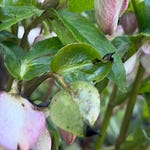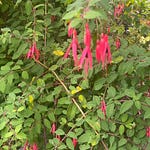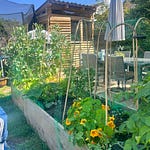Disclaimer - the video was taken on a very warm June morning, while my two teenagers enjoyed their summer playing a game, and I captured a few wobbly frames. Keeping it real, no tidying up of the background, as this is not Instagram!
In the Potting Shed – June
As the rain tip-taps on the Velux windows in an unseasonably biblical downpour, I look out toward the garden from my oak table. Tiny droplets are hammering the foxgloves, and I pray they’ll bounce back in time for the promised teatime sun. The chickens are huddled inside, and our tortoise briefly emerged from his hut for a drink, perhaps appreciating the free hydration on his dry skin.
Only yesterday, we were basking in warm midsummer sunshine. It’s incredible how changeable this month has been – no two days are the same. Still, I’m grateful. The water butts and troughs are filling up, and even the shrubs and trees are enjoying a long-awaited soak.
Top Tip: Grab trugs, pans, and pots and harvest the summer rainfall – plants prefer the nutrients from rainwater to those in tap water!
This Week in the Garden
With the cooler weather, I set a day aside to make a difference. Everything was growing wildly – needing potting on – the shed was in chaos, and the zippy greenhouse was on its last legs. It has now officially gone! I’m relying on the small cold frame to house the cucumbers (which are a little slow to get going). The potting shed has been reorganised to shelter the bigger cucumbers and courgettes, giving them a little more warmth now that temperatures have dipped.
Veg Bed Update
The borage has gone mad – I stripped away some big leaves to give the summer-sown lettuce room to breathe. The spiky borage leaves went straight into the compost bin. The radishes were harvested, leaves fed to the chickens, and the rest brought into the kitchen. I followed up with another radish succession sowing.
Spinach is now ready to harvest (hooray for homegrown greens!). The chard, peas, and beetroot are running a little behind, so they’ll treat us later in the summer. The broad beans are ready to pick – I’ve bookmarked a few delicious recipes for the weekend. Once they’re done, the runner and French beans should be coming into their own.
Tomatoes are shooting up, and we’ve spotted the first (green) fruit – no greenhouse here, so they take their time. Our strawberries are healthier this year, too. One brave little plant self-seeded under the potting shed door and produced a red fruit in the patio sun – which something has already nibbled!
The carrots, leeks, potatoes, and pumpkins have come on in the last few weeks. I’m feeling hopeful for a proper autumn harvest. A small disaster: a few onion sets from last autumn have bolted. I’ll chop and freeze what I can. Unfortunately, when I uncovered them, the chickens got in and trampled the others, so I may need to pull them early.
Flowers and Border Jobs
The pathway border remains a bit of an experiment. The bulb foliage is finally dying back. A few dahlias have popped up, and my home-sown larkspur, nigella, calendula, and cosmos are still on the small side, but I’ve planted them with hope. I’ve protected them from trampling paws with plastic sheeting and am hoping for some sunshine to bring them on.
I also added a few new perennials: a nepeta, salvia, a cola geranium (yes, the foliage really does smell like cola bottles!), and a fennel plant – all to help give the border some structure and texture.
The roses are beginning to flourish, and their perfume, mixed with herbs and sweet peas, makes the whole garden smell heavenly. I’m especially grateful for this year’s crop of sweet peas – they’re filling my kitchen table with joy.
Jobs for July
Deadhead roses regularly
Keep mowing
Sow biennial flowers for next spring
Sow and plant out kale and winter brassicas
Weed often – the rain/sun combo encourages rapid growth
Feed tomatoes, cucumbers, squashes, courgettes, peppers, and containers
Plant summer bedding
Harvest early potatoes
Prune spring-flowering shrubs and evergreens
Plant out tender annuals
Top up pond water and harvest rainwater
Harvest: gooseberries, broad beans, cucumbers, courgettes, fennel, garlic, salad leaves, radish, spinach, chard, peas, and edible flowers
Make more plant labels – reuse lolly sticks, BBQ skewers, and timber offcuts
Now that the veg beds have had some TLC, I’m turning my attention to the more overgrown areas. I’m ready to pull out the strangling weeds and give space to what’s yet to bloom – hydrangeas, agapanthus, and buddleia.
We’ve also made a lovely addition last month – a pond, made from a plastic trug! One of the three pond plants is growing brilliantly, and we’ve planted some pretty alpines around it to soften the edges. The birds have really appreciated our new addition and the dog seems to think it’s his new drinking bowl!
A Recipe to Try
I’ll be using our homegrown broad beans, potatoes, and mint in a gorgeous recipe from The Gardeners' World Almanac – A Month-by-Month Guide to Your Gardening Year. I’ve popped a screenshot of the recipe in for ease!
Let me know what’s growing where you are – are you picking broad beans yet, or is it all about the berries and herbs? I’ll be back soon with a special edition packed with Summer Solstice family fun – crafts, recipes, and little rituals to mark the turning of the year.
With sunshine, soil, and midsummer magic
Charlotte x
If a paid membership isn’t for you, but you appreciate my work, you can still support it by donating the cost of a cup of coffee. Because the beauty of everyday moments deserves to be shared, your support helps me keep writing, reflecting, and celebrating the small things that make life meaningful.








Share this post